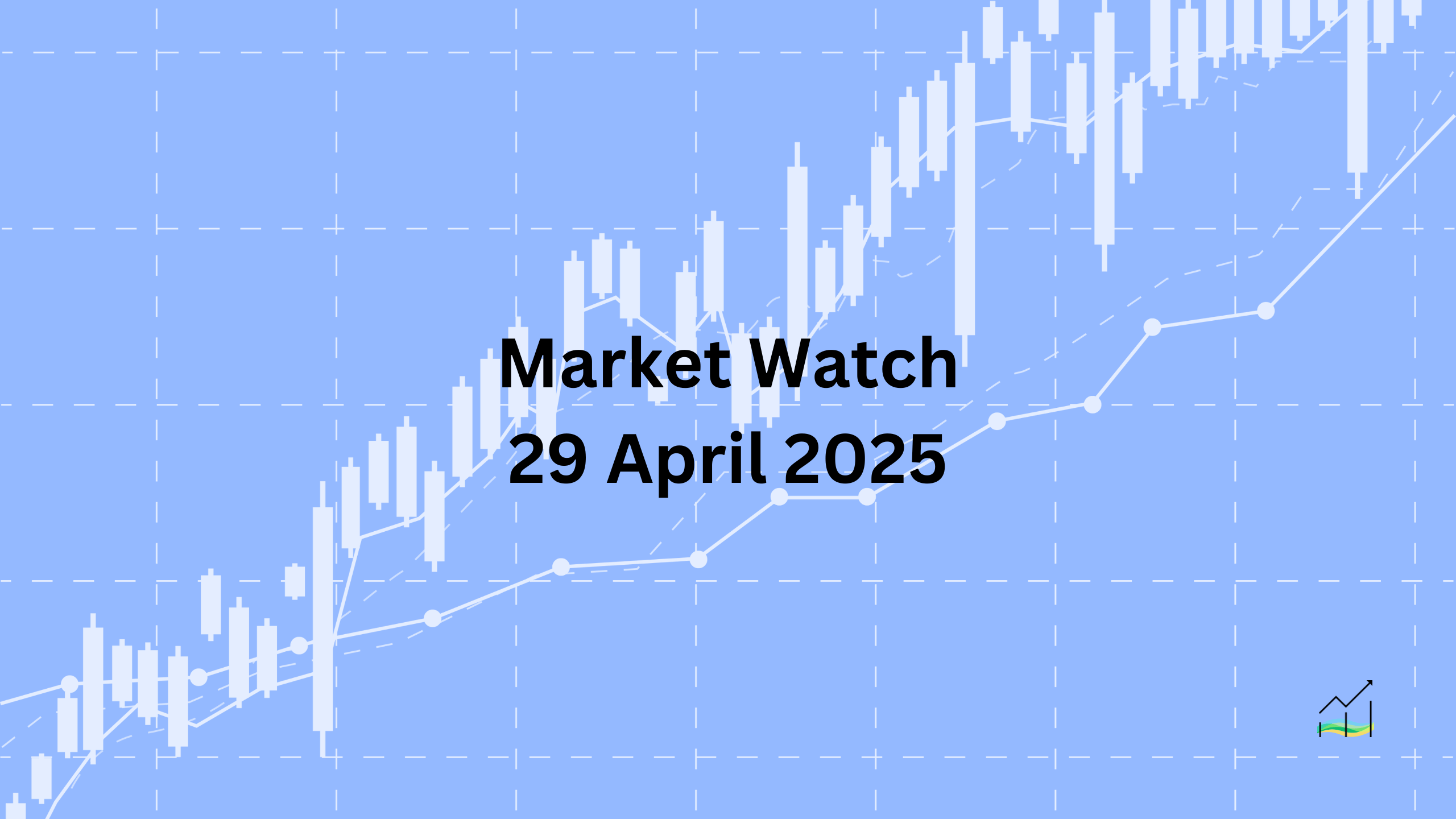29/04/2025 Market Watch

USD Firms on Trump's Tariff Easing Plans
Key Takeaways:
- The USD strengthens broadly amid reports President Trump may ease tariffs on imported auto parts and metals.
- Canadian dollar leads G10 peers post-Liberal election victory, though minority government status remains.
- Risk-sensitive currencies (JPY, CHF) weaken amid improved market sentiment.
- Equities mostly positive; Europe extends gains, US futures advance, while China lags.
- Treasury yields edge higher; Gold reverses recent gains but stays above key support at $3,300; Oil prices decline toward critical support near $60.
The US dollar has strengthened significantly across the board, buoyed by reports suggesting President Trump is preparing to announce tariff relaxations on imported auto parts and metals, specifically aluminum and steel. This anticipated move, seen as an effort to boost domestic manufacturing and automotive sectors, has energized the greenback against all G10 currencies.
Among major currencies, the Canadian dollar stands out positively following the Liberal Party's electoral success, although concerns persist due to their continued minority government position. Meanwhile, traditional safe-haven currencies like the Japanese yen and Swiss franc have declined notably, reflecting a return of risk appetite and improved sentiment in global capital markets.
Equity markets exhibit broad strength today, with Europe's Stoxx 600 marking its sixth consecutive session of gains and US index futures maintaining upward momentum following yesterday's rebound. However, Asian markets are mixed; notably, China underperforms for a second consecutive day amid ongoing domestic economic caution.
Bond markets are mixed, as European benchmark yields slightly dip despite firmer ECB inflation expectations, while US 10-year Treasury yields have moved marginally higher to around 4.23%. In commodities, gold has pulled back from recent highs yet remains steady above the critical support at $3,300, after establishing a solid footing near $3,260 last week. Conversely, June WTI oil futures continue their decline, now testing eight-day lows just under $61, approaching critical technical support at the $60 mark.
United States of America
Overview
The Dollar Index fell to a three-day low below 98.95 during North American trading yesterday, marking continued softness after last week's three-year low near 98.85. However, recent reports that President Trump may modify tariffs on autos and auto parts have provided some stability today, helping the index recover modestly to around 99.30. Despite these fluctuations, the index remains confined within a consolidation range, needing a clear break above the 100.00 threshold to signal meaningful technical strength.
Market sentiment remains cautious ahead of today's data releases, which include the goods trade deficit for March, house prices, the Conference Board’s consumer confidence index, and the JOLTS employment report. Expectations are tempered, with survey data likely to reflect existing softness. Although Fed Chair Powell and Treasury Secretary Bessent acknowledge this weakness, they've highlighted the relative resilience in the real economy—a stance likely to be challenged in the upcoming economic figures.
First-quarter growth appears nearly stagnant, with job growth notably slowing from 228k in March to approximately 130k in April. The sharp decline in container shipments from China to the US continues to unfold slowly, increasingly pressuring West Coast ports and soon expected to impact the Midwest and East Coast. Inventory accumulation, another critical indicator, may currently be underestimated in official figures, as additional reports indicate stockpiling is also happening extensively in Canada.
Economic Drivers
- President Trump’s potential easing of tariffs on autos and auto parts stabilizing USD sentiment.
- Persistent weakness in consumer and employment indicators reflecting slowing economic momentum.
- Significant decline in container shipments from China adversely affecting US logistics and supply chains.
- Inventory stockpiling in anticipation of trade disruptions, extending into Canadian markets.
Data and Events
- April 29, 2025 – March Goods Trade Deficit
- April 29, 2025 – March House Price Index
- April 29, 2025 – April Consumer Confidence (Conference Board)
- April 29, 2025 – March JOLTS Job Openings
- April 29, 2025 – US Inventory Data
Price Action
- Dollar Index consolidating near recent lows, needing a break above 100.00 for significant technical reversal.
- Near-term support identified around the 98.85–98.95 range.
- Market cautious amid upcoming economic data; risk of further downside if data disappoints.
Key Points:
- USD remains soft but stabilizing amid tariff modification reports.
- US economic data expected to reflect ongoing slowdown.
- Container shipping disruptions becoming increasingly severe.
- Inventory build-ups possibly underestimated, impacting near-term economic clarity.
Australia
Overview
The Australian dollar remains resilient, continuing to challenge the upper boundaries of its five-month trading range just above the key $0.6400 mark. After achieving a new five-month high near $0.6450 today—the highest level since last November—the currency quickly reversed, retreating to around $0.6410. Traders remain attentive to critical technical levels, notably the 200-day moving average near $0.6460, a level the Australian dollar has failed to surpass since late last year.
Attention now shifts toward Australia's first-quarter CPI data due tomorrow. Expectations point toward a slight moderation in both headline and core inflation figures on a year-over-year basis, which could influence the Reserve Bank of Australia's (RBA) near-term policy outlook. Currently, market sentiment remains cautious, given the RBA's aggressive easing stance, which positions it among the most dovish G10 central banks this year.
Futures markets have priced in substantial monetary easing, anticipating approximately 115 basis points of rate cuts in the coming months. This equates to four quarter-point reductions, with around a 60% chance of a fifth, underlining persistent concerns over Australia's economic trajectory.
Economic Drivers
- Market anticipation of upcoming Q1 inflation data, which could guide monetary policy expectations.
- RBA positioned as one of the most aggressive rate-cutting central banks in the G10.
- Significant monetary easing priced into markets amid continued economic caution.
Data and Events
- April 30, 2025 – Australia Q1 CPI (Headline & Underlying inflation rates)
Price Action
- AUD testing critical resistance near five-month highs (~$0.6450).
- Immediate technical resistance at the 200-day moving average (~$0.6460).
- Short-term support established near $0.6400, with volatility expected around CPI data release.
Key Points:
- AUD remains resilient near multi-month highs despite reversing intraday gains.
- Upcoming inflation report critical for determining next policy moves by RBA.
- Futures markets heavily pricing in further RBA rate cuts throughout 2025.
Canada
Overview
The Canadian dollar has experienced a relatively stable trading environment, with the USD/CAD pair confined largely within a narrow range. Yesterday, the currency traded between approximately CAD1.3815 and CAD1.3900, remaining comfortably within the established bounds of roughly CAD1.3800–1.3900 since mid-last week. Today's session saw a modest extension of this range, though notably the pair has held firmly above the CAD1.3800 support level.
In political developments, the Liberal Party secured a narrow victory in yesterday's election. Despite strong personal popularity and high expectations surrounding leader Mark Carney, the Liberals have again fallen short of achieving a majority and will continue governing under minority status, echoing similar political constraints experienced previously under Trudeau.
Market attention now shifts to economic data, with Canada's February GDP figures due for release tomorrow. Expectations are muted, with forecasts suggesting essentially flat economic growth for February, following a modest 0.4% expansion in January. The GDP report will be closely monitored for signs of broader economic momentum as political uncertainty continues to linger.
Economic Drivers
- Continued political uncertainty as Liberals secure minority government status under Mark Carney.
- Moderate market reaction to election results, maintaining stable currency trading ranges.
- Upcoming GDP release anticipated to reflect subdued economic conditions.
Data and Events
- April 30, 2025 – Canada February GDP (month-over-month)
Price Action
- USD/CAD remains range-bound between CAD1.3800–1.3900.
- Short-term support at CAD1.3800, resistance near CAD1.3900.
- Limited volatility anticipated, barring significant deviation in GDP data.
Key Points:
- Canadian dollar stable post-election; Liberals remain minority government.
- February GDP report expected flat, highlighting sluggish economic growth.
- USD/CAD range persists, highlighting cautious market sentiment.
China
Overview
The US dollar faced resistance near CNH7.30 yesterday, subsequently pulling back to approximately CNH7.2830. This downward momentum continued today, with the currency extending losses to around CNH7.2565—a three-and-a-half-week low. Notably, the USD/CNH rate has not closed below the key support level of CNH7.25 since mid-March, marking this as a crucial technical level to watch.
The People's Bank of China (PBOC) has incrementally adjusted its daily reference rate lower, setting today’s midpoint at CNY7.2029, slightly below yesterday’s CNY7.2043. This marks the fourth consecutive session of lowered USD/CNY fixing rates, the longest such sequence in two months, reflecting the central bank's cautious stance toward currency stability amid ongoing economic challenges.
China continues efforts to support its economy amid declining trade flows, announcing increased loan assistance to exporters. Despite public commitments to boosting domestic consumption, Beijing appears hesitant to implement large-scale stimulus measures rapidly. Additionally, Chinese officials persistently deny President Trump's claims that trade negotiations between the two countries are underway. Meanwhile, trade disruptions remain severe, with container shipments from China to the US expected to decline sharply by 40%-60%.
Economic Drivers
- PBOC's cautious adjustment of USD/CNY reference rate signaling moderate currency stabilization efforts.
- Continued support measures for exporters amid sharply declining US-bound shipments.
- Reluctance for substantial immediate stimulus despite slowing economic indicators.
- Persistent denial of active US-China trade talks despite Trump’s claims, highlighting geopolitical tension.
Data and Events
No major economic releases are scheduled today.
Price Action
- USD/CNH faces significant resistance near CNH7.30; recent pullback targets key support near CNH7.25.
- Important technical support identified at CNH7.25, not breached since mid-March.
- Daily reference rate adjustments indicating cautious policy approach.
Key Points:
- Dollar weakens to three-week lows against CNH amid moderate PBOC intervention.
- Export sector receives targeted support as shipment volumes to the US plunge sharply.
- Stimulus measures remain cautious, reflecting China's careful economic management stance.
- Ongoing diplomatic friction over trade negotiations continues to weigh on sentiment.
Europe
Overview
The euro gained momentum yesterday, breaking above the $1.1400 level in North American trading and reaching highs near $1.1425. However, it has since retreated, finding short-term support around $1.1375, comfortably within the established range from last Wednesday (~$1.1310–$1.1440). Given the current state of momentum indicators, this consolidative price action is expected to persist in the short term.
Economic sentiment data from the eurozone softened slightly, but notably, the declines have been far less severe than those observed recently in the United States. Meanwhile, inflation expectations, according to the latest ECB survey, have edged higher. Despite this, markets remain cautious, with swap rates indicating a near-certain quarter-point ECB rate cut at the upcoming June meeting.
Tomorrow’s GDP release is anticipated to highlight an important milestone, as eurozone economic growth likely surpassed that of the US for the first time in nearly three years. Although the World Economic Forum recently declared Europe "uninvestible," first-quarter eurozone growth—expected around 0.2% quarter-over-quarter—remains modest but positive. Today, Spain reported encouraging data, with Q1 GDP rising by 0.6% and harmonized April CPI stable at 2.2% year-over-year.
Economic Drivers
- Eurozone economic confidence stable relative to sharper US declines.
- Market fully pricing in an ECB rate cut at the June meeting amid cautious inflation outlook.
- Anticipated eurozone GDP outperforming the US for the first time in nearly three years despite subdued growth.
- Spain's resilient economic data providing modest regional optimism.
Data and Events
- April 30, 2025 – Eurozone Q1 GDP (quarter-over-quarter)
Price Action
- EUR/USD trading range-bound between ~$1.1310–$1.1440; recent high at $1.1425 met with immediate resistance.
- Short-term support identified at $1.1375; further consolidation expected near current levels.
Key Points:
- Euro maintains range-bound trade with limited short-term momentum.
- Eurozone economic data modestly resilient compared to sharper declines in US confidence.
- Market fully anticipates ECB easing; cautious outlook persists despite improved relative growth dynamics.
- Spain’s positive economic indicators provide regional support.
Japan
Overview
The US dollar gave back its recent gains against the yen, falling to a three-day low around JPY142.00 yesterday, after touching its lowest point since last September near JPY139.90 last week. The technical picture remains cautious, with key support levels still closely watched, particularly the 200-day moving average near JPY138.20. Today, the dollar stabilized somewhat, rebounding modestly to JPY142.70, but it needs to surpass last week's high around JPY144.00 to signal a meaningful improvement.
In policy developments, Japan's leading FX official, Mimura, refuted claims suggesting US Treasury Secretary Bessent prefers a stronger yen. Nonetheless, broader indications from top US policymakers imply support for a weaker dollar as part of a shift in US economic strategy, aiming to encourage exports rather than domestic investment abroad.
Attention shifts to domestic economic indicators tomorrow, with March retail sales and industrial production data scheduled for release. Expectations remain subdued, with industrial production projected to decline by 0.4% following February’s strong 2.3% rebound. Retail sales forecasts are also weak, anticipated to drop by 0.7% after two consecutive months of gains. Overall, the Japanese economy likely approached stagnation in Q1 2025, sharply slowing from the robust 2.2% annualized growth recorded in Q4 2024.
Economic Drivers
- Technical stabilization of the USD/JPY pair amid broader US dollar weakness signals.
- Conflicting reports on US policymakers' currency preferences, reflecting uncertainty over exchange rate direction.
- Weakening economic indicators underscore potential stagnation in Japan’s economy during early 2025.
Data and Events
- April 30, 2025 – March Industrial Production (month-over-month)
- April 30, 2025 – March Retail Sales (month-over-month)
Price Action
- USD/JPY stabilizing near JPY142.70 after testing multi-month lows near JPY139.90 last week.
- Immediate resistance at JPY144.00, with critical support near the 200-day moving average around JPY138.20.
- Price action remains cautious pending upcoming economic data.
Key Points:
- USD/JPY volatility persists near critical technical support levels.
- Economic momentum weakens significantly into Q1 2025.
- Policy uncertainty remains regarding US preferences for yen-dollar exchange rate.
- Upcoming retail and industrial data likely to confirm slowing economic conditions.
United Kingdom
Overview
Sterling posted its largest gain against the US dollar in two weeks yesterday, rising by around a cent to reach $1.3445—a new high for the year that also surpassed last year's peak. Today, the pound is holding firm within a narrow range, finding support just below the $1.3400 level, reflecting the market's continued bullish undertone.
Sterling's recent strength is also supported by its recovery against the euro. The EUR/GBP cross fell to a three-week low slightly below GBP0.8500, registering a bearish outside down day by trading on both sides of the previous session’s range and closing below Friday’s low. Downward momentum in the euro appears to be stalling after reaching about GBP0.8455 earlier today, suggesting consolidation may now dominate in the absence of major data catalysts.
With a relatively light economic calendar ahead, attention turns toward the upcoming May Day local elections. Markets are closely watching the performance of the Reform Party, expected to make notable gains. The Conservative Party, which benefited significantly in the 2021 local elections under the popularity of Boris Johnson, faces the risk of heavy losses after suffering its worst-ever parliamentary defeat last year.
Economic Drivers
- Sterling supported by technical breakout above key yearly highs.
- Continued unwinding of euro strength against the pound adds to GBP momentum.
- Political focus shifts to May Day local elections, with the Reform Party poised for significant gains.
- Conservative Party vulnerabilities in focus amid weak political backdrop.
Data and Events
No major economic releases are scheduled today.
Price Action
- GBP/USD consolidating above $1.3400 after reaching a new yearly high at $1.3445.
- EUR/GBP bearish momentum slowing after a sharp retreat toward GBP0.8455.
- Sterling remains firm ahead of key political event risks.
Key Points:
- Sterling reaches fresh yearly highs amid technical and political tailwinds.
- Euro weakens sharply against the pound but shows signs of near-term stabilization.
- May Day elections could mark a pivotal shift in the UK's political landscape.
- Conservative Party risks renewed political setbacks following historic parliamentary losses.
© 2025 SKONE Enterprise (003319453-V). All rights reserved.
The content on this site is for informational purposes only and does not constitute financial advice.


